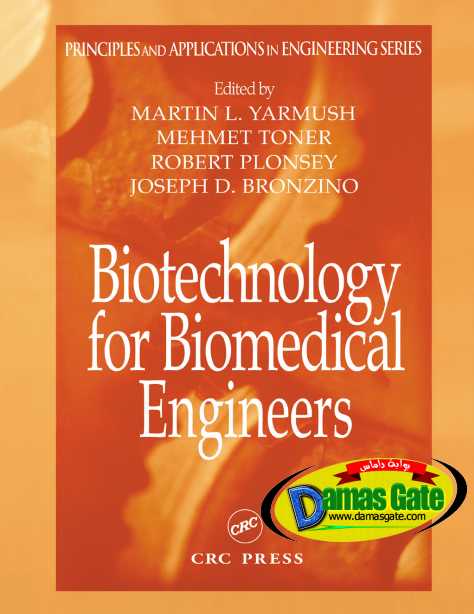Biotechnology for Biomedical Engineers - Martin L. Yarmush et al

Preface
The human genome project has altered the very nature of research and development related to the
treatment of disease and, in the process, has revolutionized the field of “biotechnology.” Pioneering
work in genomics, for example, has led to the development of sophisticated techniques for determining
differential gene-expression patterns (transcriptomics) resulting from genetic makeup, disease slate or
influence from external factors. This book—Biotechnology for Biomedical Engineers—takes the sections
most relevant to this important topic from the second edition of the Biomedical Engineering Handbook
published in 2000. Since it is important for individuals engaged in this field to understand the fundamentals
of physiology, this handbook opens with a section on Physiologic Systems, edited by Robert Plonsey,
which provides an overview of the major physiologic systems of current interest to biomedical engineers,
namely the cardiovascular, endocrine, nervous, visual, auditory, gastrointestinal and respiratory systems.
It is important to note that this section is written at an introductory and tutorial level. However, since
this book has been prepared for the biomedical engineering community, mathematical descriptions are
not avoided.
In the subsequent chapters, the major editors, Drs.Martin Yarmush and Mehmet Toner, have assembled
material that covers most topics in biotechnology that might interest the practicing biomedical engineer.
During the past two decades, the field of biotechnology in the advent of recombinant DNA technology,
monoclonal antibody technology, and new technologies for studying and handling cells and tissues, has
gone through a tremendous resurgence in a wide range of applications pertinent to industry, medicine,
and science in general. Some of these new ideas, concepts, and technologies are covered in this handbook.
With this in mind, the Biotechnology for Biomedical Engineers Handbook presents:
- Approaches and techniques to manipulate genetic materials. This capability, which provides
the practitioner with the potential to generate new proteins with improved biochemical and
physiochemical properties, has led to the formation of the field of protein engineering.
- The field of monoclonal antibody production in terms of its basic technology, diverse
applications, and ways that the field of recombinant DNA technology is currently “reshaping”
some of the earlier constructs.
- Applications of nucleic acid chemistry, as well as the burgeoning field of antisense technology,
with emphasis on basic techniques and potential applications to AIDS and cancer.
- The computational, chemical, and machine tools that are being developed and refined for
genome analysis.
- The fundamentals of applied virology in which viral vaccines and viral-mediated gene therapy
are the main foci.
- Important aspects of cell structure and function, emphasizing a common approach toward
quantitative analysis of cell behavior in order to develop the principles for cell growth and
function.
Download
*

Preface
The human genome project has altered the very nature of research and development related to the
treatment of disease and, in the process, has revolutionized the field of “biotechnology.” Pioneering
work in genomics, for example, has led to the development of sophisticated techniques for determining
differential gene-expression patterns (transcriptomics) resulting from genetic makeup, disease slate or
influence from external factors. This book—Biotechnology for Biomedical Engineers—takes the sections
most relevant to this important topic from the second edition of the Biomedical Engineering Handbook
published in 2000. Since it is important for individuals engaged in this field to understand the fundamentals
of physiology, this handbook opens with a section on Physiologic Systems, edited by Robert Plonsey,
which provides an overview of the major physiologic systems of current interest to biomedical engineers,
namely the cardiovascular, endocrine, nervous, visual, auditory, gastrointestinal and respiratory systems.
It is important to note that this section is written at an introductory and tutorial level. However, since
this book has been prepared for the biomedical engineering community, mathematical descriptions are
not avoided.
In the subsequent chapters, the major editors, Drs.Martin Yarmush and Mehmet Toner, have assembled
material that covers most topics in biotechnology that might interest the practicing biomedical engineer.
During the past two decades, the field of biotechnology in the advent of recombinant DNA technology,
monoclonal antibody technology, and new technologies for studying and handling cells and tissues, has
gone through a tremendous resurgence in a wide range of applications pertinent to industry, medicine,
and science in general. Some of these new ideas, concepts, and technologies are covered in this handbook.
With this in mind, the Biotechnology for Biomedical Engineers Handbook presents:
- Approaches and techniques to manipulate genetic materials. This capability, which provides
the practitioner with the potential to generate new proteins with improved biochemical and
physiochemical properties, has led to the formation of the field of protein engineering.
- The field of monoclonal antibody production in terms of its basic technology, diverse
applications, and ways that the field of recombinant DNA technology is currently “reshaping”
some of the earlier constructs.
- Applications of nucleic acid chemistry, as well as the burgeoning field of antisense technology,
with emphasis on basic techniques and potential applications to AIDS and cancer.
- The computational, chemical, and machine tools that are being developed and refined for
genome analysis.
- The fundamentals of applied virology in which viral vaccines and viral-mediated gene therapy
are the main foci.
- Important aspects of cell structure and function, emphasizing a common approach toward
quantitative analysis of cell behavior in order to develop the principles for cell growth and
function.
Download
*